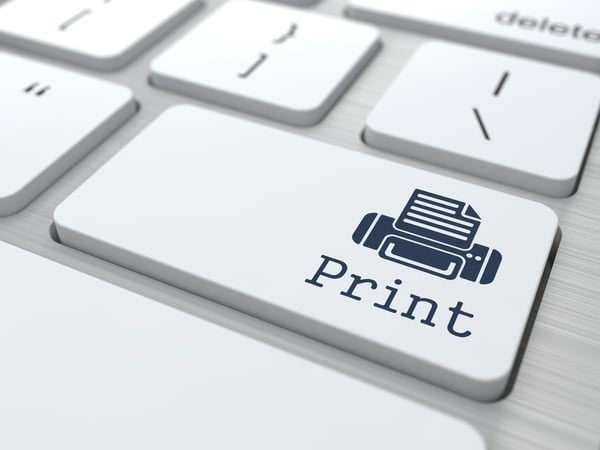What Types Of Printing Are Used For Flexible Packaging?
Are you running stand-up pouches, films, labels, or another type of flexible packaging? If so, you have more printing options than you might realize. There are various types of printing and curing technology that you can use to add colors, text, and graphics to your compliant packaging supplies.
Here at Industrial Packaging, we often get questions about how to implement printing technologies for flexible packaging supplies. In this article, we will review the different types of printing applications for flexible packaging materials and related substrates.
What Are The Different Methods For Printing On Flexible Packaging Materials?
- Flexography
- Digital Printing
- Rotogravure
- Lithography
1. Flexography
Flexography (AKA: flexo) is a type of printing technology that uses a flexible, (rather than a solid) plate. It is a newer incarnation of relief printing. Flexo is a widely used printing method.
Commonly used flexible packaging supplies that utilize flexography include plastics and stand-up pouches. Flexography is found throughout the packaging industry for printing graphics, text, and images on non-porous materials used for multiple applications of food packaging.
2. Digital Printing
Digital printing is an ink-jet based printing method in which graphics and branding elements are applied directly on plastic substrates. Modern digital printing negates need for labels and cardboard inserts. This results in a significant reduction in waste, lower inventory requirements, and faster speed to market dynamics.

Additionally, digital printing technologies for flexible packaging now allow for variable and dynamic content for flexible packaging printing applications. This allows for a vast array of graphic and text applications for targeted subgroups of consumers and buyer personas.
Hold up, variable and dynamic content? What is that?
From IWCO Direct:
"Variable content consists of chunks of text or images that are swapped in and out of a letter based on basic 1-to-1 matches/lookups from data values representing larger market segments.
Dynamic content takes the normal amount of market segments in variable content and breaks them down even further into target sub-groups based on any combination of demographic, geographic, psychographic and behavioristic data. This is where real 1-to-1 communications come to life.
Dynamic content consists of not only swapping out content, but modifying formats (fonts, spacing, colors, etc.) based on more complex logic that validates multiple data points identifying specific market segments.
The results from using dynamic content can be impressive. For example, a DM News story reported that Robert Morris University achieved a 79% lift in response rates among prospective students by using dynamic content and pURLs compared to its generic campaigns."
Basically, dynamic content is content that is manually or automatically updated on a regular basis based upon data from very specific market segments. The content is then hyper focused on specific buyer personas with the intention of improving the effectiveness of the content in getting the buyer to make a purchase.
Variable content is collections of text and images that are regularly changed or updated based upon data sets pertaining to 1-to-1 matches for larger market segments.
Interested In Running Printed Shrink Film To Spice Up Your Products Branding And Visual Appeal?
3. Rotogravure
Rotogravure is a method of printing that engraves graphics onto a plate, form, cylinder or another surface before being applied to the final substrate. With the gravure printing method, graphics, text, and other imagery are engraved upon the surface of an image carrier (for example, a cylinder or plate).

Not unlike flexography, rotogravure utilizes rotary printing techniques and similar machinery. Rotogravure is used for applications including but not limited to commercial printing of magazines, newspapers, cardboard boxes, and some types of flexible packaging. In terms of flexible packaging, the process is commonly used for stand-up pouches.
4. Lithography
The method of lithographic printing utilizes a graphic made from oil which is then drawn on the top of a level lithographic plate. Next the plate is treated with acid.
The part of the lithographic plate that remains unprotected by the oil results in the etching of the image. Afterward, water is applied to the plate resulting in the etched areas retaining water.
Next, an oil-based ink is applied to the surface of the plate. The ink being resisted by the water results in ink only sticking to the graphic.
At the end of this process, the ink is moved to a blank substrate. This results in the final lithographic print of the graphic design. This method, while quite out-dated, is still used in the creation of prints for artistic applications.
Today, the graphic element is usually made of a polymer coating, which is then placed on a plastic or metal plate. The graphic is then printed onto the plate in reverse or mirrored application. Additionally, offset lithography can be accomplished by placing the graphic upon a flexible substrate (most commonly rubber) for print applications.
While lithography is not commonly used for printing directly upon flexible packaging supplies, it is commonly used to print upon labels that are then later applied to flexible packaging materials for shipping or other instructional purposes.
Which Type Of Printing Is Right For Your Flexible Packaging Supplies?
When choosing a method of printing for your flexible packaging supplies, you will want to meet and discuss your packaging materials with your selected printer. Depending upon what type of material you are using in conjunction with your design, graphic, and textual elements, one method of printing may be better than another.
For example, if cost is a major factor and you do not have a large budget for printing, flexography offers a low cost and fast turn around time. However, the image quality is not the best and often results in banding issues with gradients. Additionally, flexography is also not capable of producing quality photographic images.
On the other hand, if you have a larger budget and want high quality with no banding, lithography may be a better choice as it produces excellent quality images. Unfortunately, lithography is often one of the most expensive types of printing. Lithography is limited to flat surfaces, has a long lead time and often requires high minimum order requirements that can be very costly.
If you are unsure where to start in your quest to choose the best printing option for your flexible packaging supplies, it would be well advised to reach out to at least 3 or 4 vendors. Speak with a knowledgeable representative from each vendor and request information about printing capabilities and which type would be best for your products.
If possible, bring in your rep to analyze your packaging line, products and current packaging materials. This will allow them to inform you on which type of printing is best suited to your unique configuration.
In many cases, working with a local packaging vendor can significantly reduce the work involved in sourcing the appropriate materials and the subsequent printing methods available for your specific needs.
About Nathan Dube
As the Digital Marketing Specialist at Industrial Packaging, I am honored to create content for such a phenomenal company and work with one of the greatest teams in the Packaging Industry. Whether creating a video, writing blog posts or generating other pieces of content and multimedia, I am always excited to help educate and inspire our prospects and clients to reach their highest potential in regards to their packaging processes and needs.




